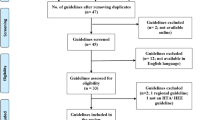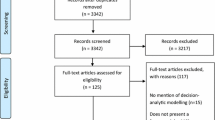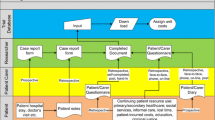Summary
Economic analysis has become increasingly important in healthcare in general, and particularly with respect to pharmaceuticals. Therefore, it is vital that the methods used in such evaluations are carefully scrutinised and refined. However, guidelines contain only a limited number of recommendations for the use of secondary data in modelling studies.
In this manuscript, the selection of data sources in modelling studies will be addressed. The objectives of this manuscript are as follows: (i) to present a general strategy on how to determine the appropriateness of a data source for a model; and (ii) to present recommendations on a transparent reporting format for the selection of data sources.
Similar content being viewed by others
References
Australia Commonwealth Department of Health, Housing and Community Services. Guidelines for the pharmaceutical industry on preparation of submissions to the Pharmaceutical Benefits Advisory Committee. Canberra: Commonwealth Department, 1992
Commonwealth of Australia Department of Human Services and Health. Guidelines for the pharmaceutical industry on preparation of submissions to the Pharmaceutical Benefits Advisory Committee including major submissions involving economic analysis. Canberra: Australian Government Publishing Service, 1995
Canadian Coordinating Office for Health Technology Assessment (CCOHTA). Guidelines for economic evaluation of pharmaceuticals: Canada. 1st ed. Ottawa: CCOHTA, 1994
Ontario guidelines for economic analysis of pharmaceutical products. Ontario: Canadian Ministry of Health, Drug Programs Branch, 1993
Weinstein MC, Fineberg HV. Clinical decision analysis. Philadelphia: WB Saunders Co., 1980: 228–65
Egger M, Davey-Smith G. Misleading meta—analysis. BMJ 1995; 310: 752–4
Detsky AS, O’Rourke KO, Corey PN, et al. The hazards of using active clinic patients as a source of subjects for clinical studies. J Gen Intern Med 1988; 32: 260–6
Sacket DL. Bias in analytical research. J Chronic Dis 1979; 32: 51–63
Jariath N, Weinstein J. The Delphi methodology (part 2): a useful administrative approach. Can J Nurs Adm 1994; 7 (4): 7–20
Jones J, Hunter D. Consensus methods for medical and health services research. BMJ 1995; 311: 376–80
Barr J, Schumacher G. Using decision analysis to conduct pharmacoeconomic studies. In: Spilker B, editor. Quality of life and pharmacoeconomics in clinical trials. 2nd ed. Philadelphia: Lippincott—Raven Publishers, 1996: 1197–214
Williams P, Webb C. The Delphi technique: a methodological discussion. J Adv Nurs 1994; 19: 180–6
Evans C. The use of consensus methods and expert panels in pharmacoeconomic studies: practical applications and methodological shortcomings. Pharmacoeconomics 1997; 12 (2 Pt 1): 121–9
Nuijten MJC, Hardens M, Souetre E. A Markov process analysis comparing the cost effectiveness of maintenance therapy with citalopram versus standard therapy in major depression. Pharmacoeconomics. 1995; 8 (2): 159–168
Clinical practice guideline. Depression in primary care: treatment of major depression (AHCPR publication no. 93-0551). Rockville (MD): Public Health Service, Agency for Health Care Policy and Research, 1993
Rosenberg C, Damsbo N, Fuglum E, et al. Citalopram and imipramine in the treatment of depressive patients in general practice: a Nordic multicentre clinical study. Int Clin Psychopharmacol 1994; 9 Suppl. 1: 41–8
Rote Liste 1993. Arzneimittelverzeichnis des BPI. Aulendorf/Würtemberg: Edition Cantor Verlag für Medizin und Naturwissenschaften GmbH, 1993
BMA. Bewertungsmass—stab für kassenärtzliche Leistungen. Cologne: Deutscher Artze—Verlag GmbH, 1993
DOK-8: AOK-Bundesverband 1994 Apr 15: 256
Montgomery SA, Rasmussen JGC, Tanghoi P. A 24−week study of 20 mg citalopram and placebo in the prevention of relapse of major depression. Int Clin Psychopharmacol 1993; 9: 181–8
Clemens K, Townsend R, Luscombe F, et al. Methodological and conduct principles for pharmacoeconomic research. Pharmacoeconomics 1995; 8 (2): 169–74
Drummond MF, Jefferson TO. Guidelines for authors and peer reviewers of economic submissions to the BMJ. BMJ 1996; 313: 275–83.
Jefferson T, Demichelli V. Are guidelines for peer—reviewing economic evaluation necessary? A survey of current editorial practice. Health Econ 1995; 4: 383–8
Author information
Authors and Affiliations
Corresponding author
Rights and permissions
About this article
Cite this article
Nuijten, M.J.C. The Selection of Data Sources For Use in Modelling Studies. Pharmacoeconomics 13, 305–316 (1998). https://doi.org/10.2165/00019053-199813030-00005
Published:
Issue Date:
DOI: https://doi.org/10.2165/00019053-199813030-00005




